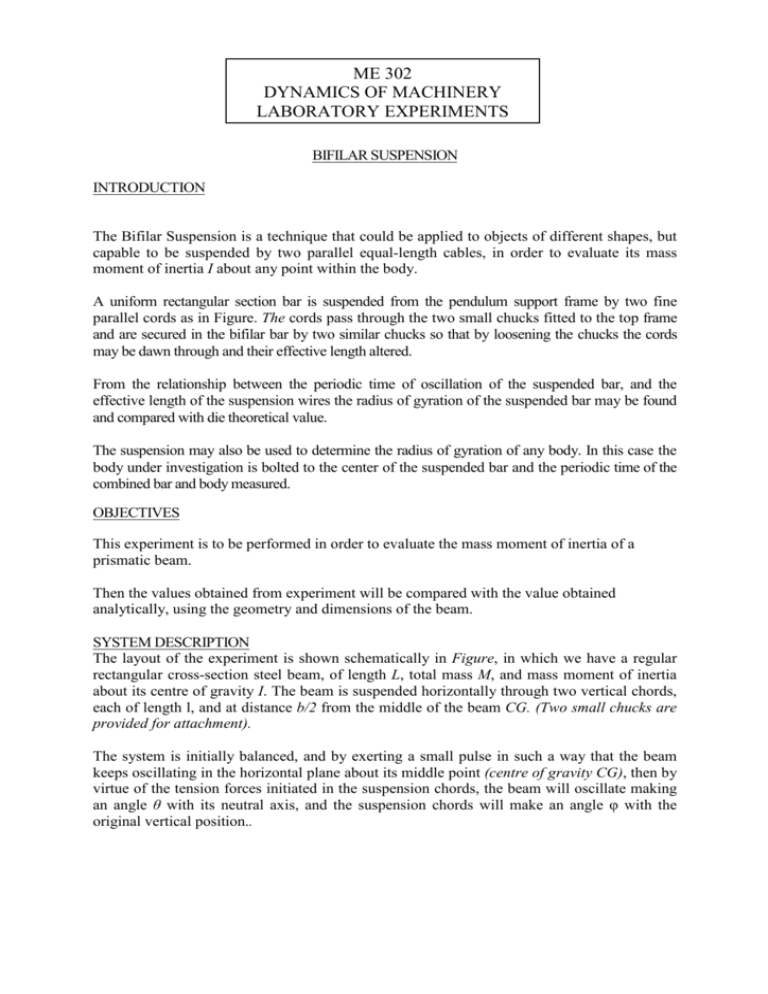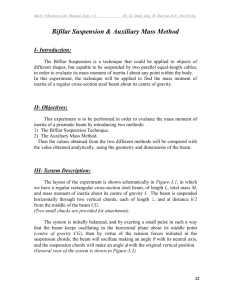Bifilar Suspension
advertisement

ME 302 DYNAMICS OF MACHINERY LABORATORY EXPERIMENTS BIFILAR SUSPENSION INTRODUCTION The Bifilar Suspension is a technique that could be applied to objects of different shapes, but capable to be suspended by two parallel equal-length cables, in order to evaluate its mass moment of inertia I about any point within the body. A uniform rectangular section bar is suspended from the pendulum support frame by two fine parallel cords as in Figure. The cords pass through the two small chucks fitted to the top frame and are secured in the bifilar bar by two similar chucks so that by loosening the chucks the cords may be dawn through and their effective length altered. From the relationship between the periodic time of oscillation of the suspended bar, and the effective length of the suspension wires the radius of gyration of the suspended bar may be found and compared with die theoretical value. The suspension may also be used to determine the radius of gyration of any body. In this case the body under investigation is bolted to the center of the suspended bar and the periodic time of the combined bar and body measured. OBJECTIVES This experiment is to be performed in order to evaluate the mass moment of inertia of a prismatic beam. Then the values obtained from experiment will be compared with the value obtained analytically, using the geometry and dimensions of the beam. SYSTEM DESCRIPTION The layout of the experiment is shown schematically in Figure, in which we have a regular rectangular cross-section steel beam, of length L, total mass M, and mass moment of inertia about its centre of gravity I. The beam is suspended horizontally through two vertical chords, each of length l, and at distance b/2 from the middle of the beam CG. (Two small chucks are provided for attachment). The system is initially balanced, and by exerting a small pulse in such a way that the beam keeps oscillating in the horizontal plane about its middle point (centre of gravity CG), then by virtue of the tension forces initiated in the suspension chords, the beam will oscillate making an angle θ with its neutral axis, and the suspension chords will make an angle φ with the original vertical position.. Where; b=distance between the wires(m) l =Length of suspension(m) Natural Frequency Period of Oscillation EXPERIMENTAL PROCEDURE 1- Attach the first chord to the main frame and measure its length, then attach the second chord to the main frame with the same length as the first one. (The length to be measured and included in the calculations l should include boththe chord’s length and the chuck’s height, see in Figure) 2- Insert a slender rod through the middle hole of the beam, to provide as an axis of rotation for the beam. 3- Hold the slender rod in place and give the beam a small displacement from one of its ends in the transverse direction. The beam should oscillate in the horizontal plane only. 4- Measure the time elapsed to complete ten oscillations T. 5- Release the chords then re-attach them at another length l, and repeat steps-2, 3& 4. 6- Repeat step-5 four more times to get total six pairs of l and T. RESULTS L(m) T(s) Parameter L(mm) w(mm) h(mm) b(mm) r(mm) Value Parameter rc(mm) hc(mm) R(mm) hm(mm) Value Questions 1) DrawT2 versus L and find slope of drawing will give Inertia term. 2) Compare analytical and experimental inertia terms. 3) Referring to the derivation of the equation of motion for the beam, why is it important to keep the angle of oscillation of the beam small during the execution of the experiment? What is the basic assumption that is based on assuming a small angle of oscillation?









